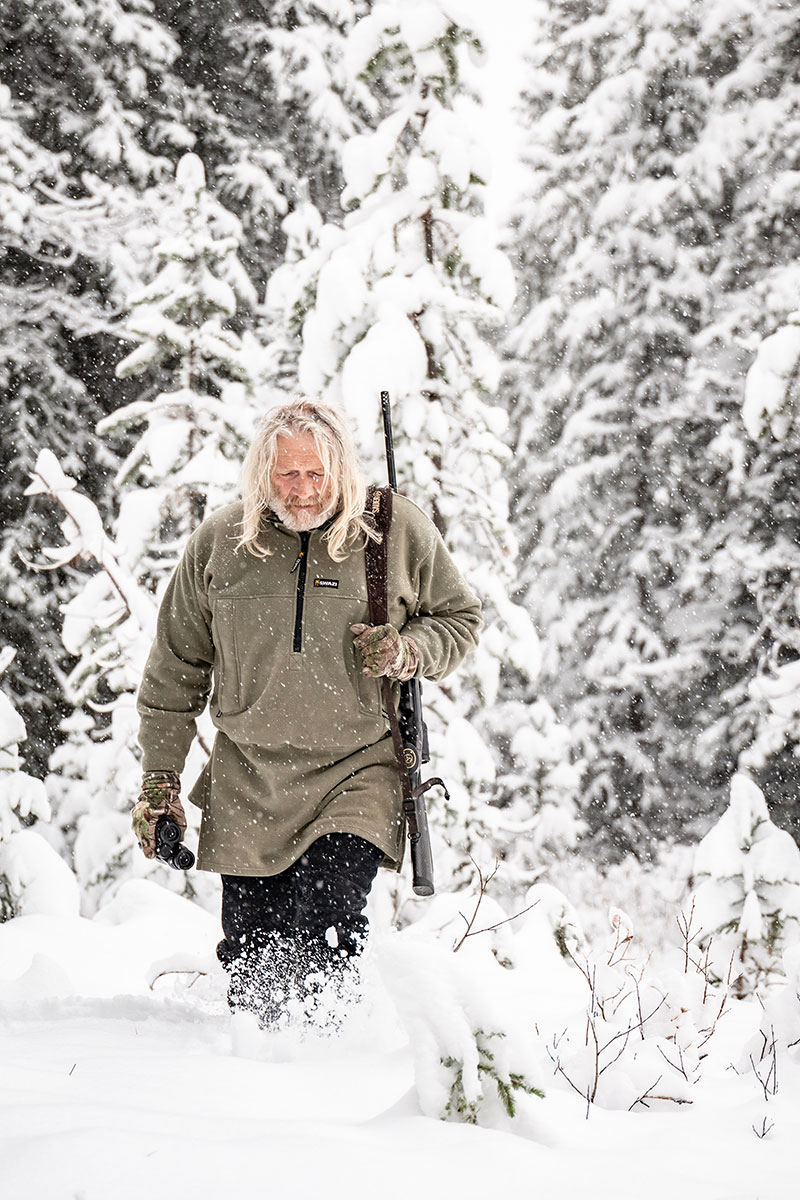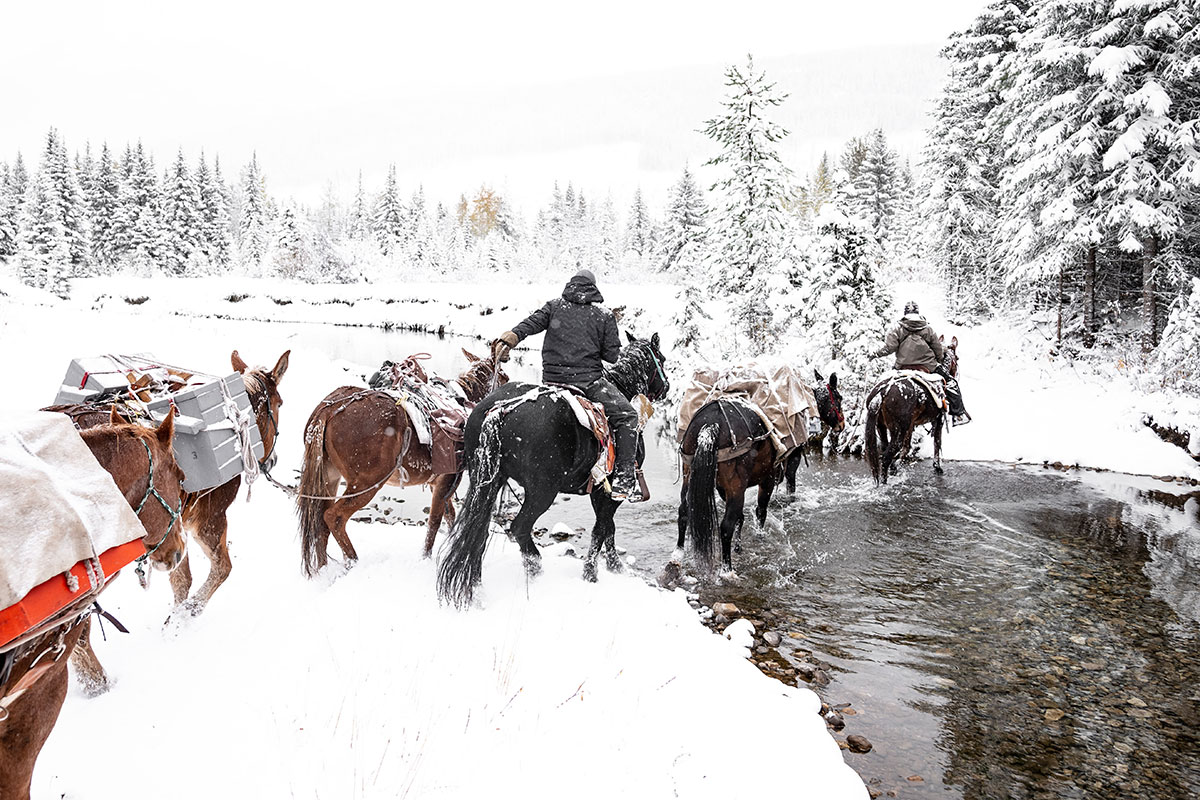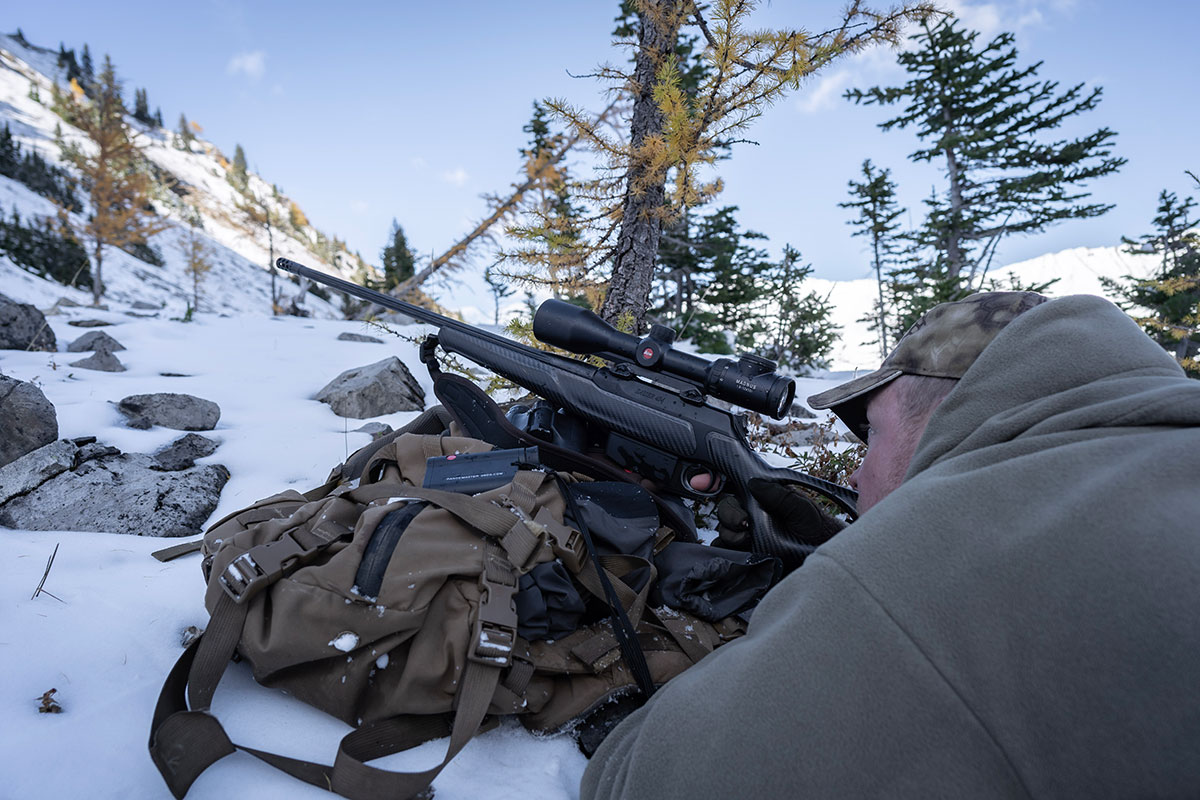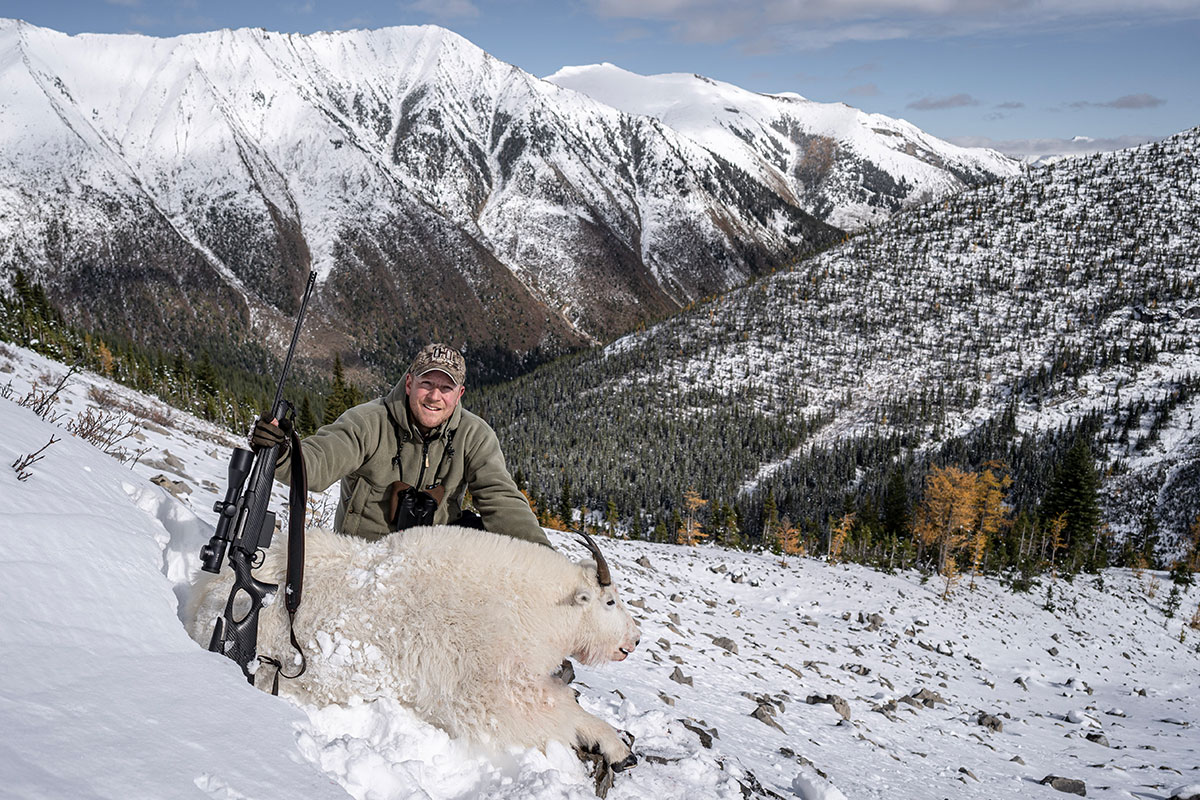Mountain Goat Quest In British Columbia
 Mountain goats were one of the first mountain-dwelling ungulates to capture my imagination and encourage me to hunt outside of Europe. I saw a fully mounted billy standing on a near-scale faux mountain peak at my first Dallas Safari Club convention some 11 years ago. I was intrigued by this unusual looking white creature.
Mountain goats were one of the first mountain-dwelling ungulates to capture my imagination and encourage me to hunt outside of Europe. I saw a fully mounted billy standing on a near-scale faux mountain peak at my first Dallas Safari Club convention some 11 years ago. I was intrigued by this unusual looking white creature.
I finally got around to planning a goat hunt and my friends at Hornady suggested Ryan Danstrom, of Quarrie Creek Outfitters in British Columbia was the man to talk to. When mentioning my plans to an avid Kiwi hunting friend, Davey Hughes, he promptly invited himself along – not to hunt, having taken mountain goats before, just for a week in the wilderness. Such is the awesome beauty of the British Columbian Rockies. This proves that for those of us who travel to these wild places, it isn’t just about killing something – there’s something far more complex in our desires to be there. It’s about escaping the daily grind of computers and phone calls and being immersed in nature. Nothing beats the vitality that creeps back into your soul during a week in the wilderness. A week on the edge of danger, of physically demanding activity and away from the unnatural things that have infested our existence, separating us from nature.
Goat hunts are always booked for eight days – the weather and animals are just too unpredictable, so on Ryan's suggestion, I’d also obtained a tag for elk in case we got lucky. Little was I to know quite how lucky we would be. As my week approached, I looked on the weather forecast with increasing worry – three weeks solid of rain, cloud and then very early season snow preceding our trip, so what would that mean for us? Amazingly, the day before we arrived the weather changed and while cold and plenty of snow on the ground, it looked like we’d have clear skies. A great recipe for glassing mountain tops and tracking.
Now Ryan, our guide, is an old-school outfitter – the entire hunt is done with horses, riding for six hours a day, then on foot for the steeper climbs. The log burner-heated cabins are rustic but comfortable and the landscape is reminiscent of the Hollywood film The Revenant – largely unscathed by human interference, one of those rare places in a first-world country that still enjoys true wilderness, many miles from the mining towns that hold the bulk of the population in this area.
Having ridden into camp the day before, the weather was on our side after three weeks of no visibility, so we wasted no time riding out at first light on the horses. We made our way from camp, which was at around 5,000 feet, to around 6,000 feet, scouting the walls of the valley as we rode. Davey and Ryan were on mules, while I was on a bay gelding named Quatra.
 “I’ve been hunting here since around 1999, so 20-odd years and worked for the previous owners of this outfit,” Ryan told me as we rode. He’s also worked in the Yukon and Northwest Territories, but clearly this is his home turf. “We have nine horses and mules in camp right now, so that we have enough to carry the packs, but also to switch them out when they’ve had a long day. It’s hard going for them and people are always amazed at the many miles we cover every day. They are so adaptable, it’s a major part of the experience people come for.” We were riding on trails with any fallen timber cut to allow ease of passage, which Ryan spends many days preparing during the summer off-season. He says this alone is a huge part of the undocumented conservation work that hunters and hunting outfitters such as him do.
“I’ve been hunting here since around 1999, so 20-odd years and worked for the previous owners of this outfit,” Ryan told me as we rode. He’s also worked in the Yukon and Northwest Territories, but clearly this is his home turf. “We have nine horses and mules in camp right now, so that we have enough to carry the packs, but also to switch them out when they’ve had a long day. It’s hard going for them and people are always amazed at the many miles we cover every day. They are so adaptable, it’s a major part of the experience people come for.” We were riding on trails with any fallen timber cut to allow ease of passage, which Ryan spends many days preparing during the summer off-season. He says this alone is a huge part of the undocumented conservation work that hunters and hunting outfitters such as him do.
“We really look after this wilderness, which is something rarely acknowledged. The tag money you pay goes towards conservation, sure, but in terms of boots on the ground, that’s us. We are the guardians of areas like this, where you cannot get with vehicles. We also send samples of the animals that are hunted in for records and the tag has to be verified by our local officials,” Ryan explained.
The wildlife in this area is incredibly diverse, with not only mountain goats and elk, but whitetail, mule deer, Rocky Mountain bighorn sheep, moose, lynx, bobcat, wolf, grizzlies and black bears. Most of these are hunted to some extent, all in a highly controlled manner with census information and tags, though grizzlies were taken off the list last year.
As Ryan puts it: “It’s a decision that was made in the high towers, not by people with their feet on the ground, putting in the actual work. You don’t have to like what we do, but it’s hard when decisions are made for emotional reasons rather than scientific ones. Grizzlies are a species that do bring up an emotional reaction.”
Time passed pretty quickly, talking with Ryan and Davey and admiring the ever-more wild landscape, the rhythm of our mule and horses’ hooves changing as we climbed steeper and steeper trails, and started paying more attention to the slopes above us, scanning for the white, square body of the mountain goat.
 Three hours in and we saw some, but they were females, and while we were allowed to shoot them, Ryan tries only to take out mature males. It was another couple of hours on the horses before we spotted a single goat, a pretty good sign that it would be a billy rather than a nanny.
Three hours in and we saw some, but they were females, and while we were allowed to shoot them, Ryan tries only to take out mature males. It was another couple of hours on the horses before we spotted a single goat, a pretty good sign that it would be a billy rather than a nanny.
“That’s a mature male,” Ryan said. “Let’s go for it.” We tethered our rides, hydrated with some ice-cold water from the from the creek and started climbing. The billy we’d seen was a good distance from us, still a steep climb away, but Ryan’s calm demeanour somehow gave me confidence that this would not be a wasted climb.
An hour in and we’d made good progress and were now starting to slow down to make sure we didn’t bump anything we may not have seen and give the game away. And indeed, it was the right moment to slow as we came across a nanny and kid, just a few hundred yards below where we’d seen the billy. We knew if the nanny scented or saw us, we’d be finished for the day, so we slowed, pondering every step, moving quietly over the snowy slopes.
Our slow progress got us ever closer, and then, quite suddenly, the billy disappeared from sight, – but Ryan, knowing this territory, wasn’t worried. “It’ll come back into view shortly. Let’s just sit up here for a moment.” We were on a reasonably flat area, and a large rock with a pack draped over it nestled into the snow made a good resting spot for the spotting scope.
Using the latest handheld rangefinder from German optics supremo Leica, Davey ranged the point at which we’d last seen the goat: “That’s 363 yards,” he told me. Having linked the app to load my ballistic data into the device earlier, I was able to make the requisite clicks on my scope, which would account for the angle, temperature, drop and altitude offering me the greatest peace of mind that my first shot would count. We settled and waited.
It didn’t take long until there, above us, right where Ryan said, the billy appeared. It wasn’t moving fast, just slowly traversing the near vertical face. “Whenever you are ready, no rush,” Ryan said. And so, calmly, with both elbows rested in snow, my favourite shooting position, I took my time, held point of aim exactly on the scapula, and squeezed. None of this was dramatic – in this wild, hostile, unpredictable territory, the shot was one of the most controlled moments I’d had for a long time.
It was, however, what happened next that was dramatic: the reaction to the shot was instantaneous and violent. All four of the goat’s legs went rigid, and it toppled over on its side – unfortunately over the downward slope. Head over heels its dead weight plummeted, and every time it hit a rock, Ryan winced, worrying its horns might break. For me, there was the usual sense of relief that my bullet had found its mark and done its job cleanly. We watched as the billy bounced down, off the rocks and into powdered snow, ploughing to rest conveniently just 100 yards from us, no longer a steep and challenging climb away.
 Remarkably, the horns were intact, and the rings told us it was an 11-year-old, an old age for these wild mountains. As we made our way back to camp, darkness caught up with us, and the dramas of the day replayed in my mind. The horses’ hooves were the only sound, clattering on the rocks, their shoes sending sparks up into the crystalline air. We drew closer to camp, welcomed by a plume of smoke visible against the dark sky, the smell of woodsmoke signalling warmth and comfort for the night. Ryan wasted no time, first seeing to the horses, then skinning the goat and feeding us on the tender backstraps, which he rubbed with a secret mix of spices, flash-fried in the pan and we wolfed down. Day one and we had completed our main mission.
Remarkably, the horns were intact, and the rings told us it was an 11-year-old, an old age for these wild mountains. As we made our way back to camp, darkness caught up with us, and the dramas of the day replayed in my mind. The horses’ hooves were the only sound, clattering on the rocks, their shoes sending sparks up into the crystalline air. We drew closer to camp, welcomed by a plume of smoke visible against the dark sky, the smell of woodsmoke signalling warmth and comfort for the night. Ryan wasted no time, first seeing to the horses, then skinning the goat and feeding us on the tender backstraps, which he rubbed with a secret mix of spices, flash-fried in the pan and we wolfed down. Day one and we had completed our main mission.
I breathed the cold, glass-sharp air outside the cabin, using the satellite phone to tell my family the news. However, it turned out that they had news too. The story had just hit the media that Zac Goldsmith, Minister for International Wildlife, was proposing a complete ban on import and export of trophies. I could barely believe it. I told Ryan, whose reaction was one of dismay and shock.
“Don’t they realise what that means for conservation? For places like this, which rely on hunting tourism, where the tag pays for conservation and the guides rely on it for our employment?” Ryan gasped. We mulled over the shocking news, discussing what far-reaching consequences a ban such as this will have worldwide before heading to bed. And while the news was depressing, to put it mildly, I couldn’t help but be cheered by the knowledge that I’d be spending the rest of the week looking for elk and immersing myself in the wilderness, which is the real allure for these trips. –Photos and text by Simon K. Barr

